With U.S. beer consumption remaining weak, lessening demand for malting barley, food, seed, and industrial use of barley is lowered, offsetting lower imports from Canada. World coarse grain production for 2010/11 is increased slightly, boosting ending stocks. Forecast U.S. corn and sorghum prices are unchanged this month, but the barley price is lowered and the oats price range is narrowed. Much of these two crops are already marketed, with prices to date lower than expected.
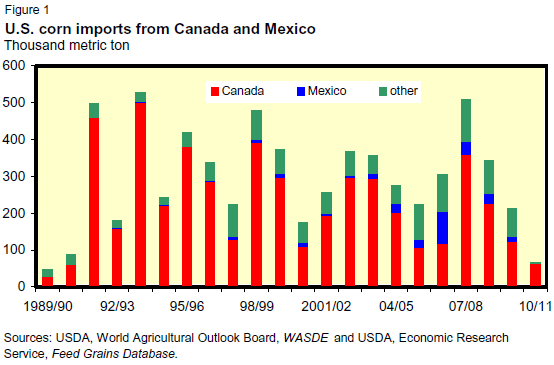
Domestic Outlook
Feed Grain Use Lowered Slightly for 2010/11
U.S. feed grain supplies for 2010/11 are nearly unchanged as a small increase in corn imports is offset by a reduction in barley imports. Total supply is forecast at 382.3 million metric tons for 2010/11, down from 398.3 million tons in 2009/10. Imports are forecast at 2.0 million tons. There are no changes to feed grain production this month.
Total feed grain utilization is forecast 0.1 million tons lower this month at 357.6 million. This reflects a decrease in barley food, seed, and industrial use due to slow domestic beer consumption, which is slowing demand for malting barley. There are no changes to feed and residual use or exports.
Feed Use
On a September-August marketing year basis for 2010/11, feed and residual use for the four feed grains plus wheat is projected to total 144.9 million tons, unchanged from last month, but up 3.3 million tons from 141.6 million in 2009/10. Corn is estimated to account for 93 percent of feed and residual use in 2010/11, the same proportion as in 2009/10.
The projected index of grain-consuming animal unit (GCAU) in 2010/11 is 92.5 million units, up from 92.3 million last month and up from 91.6 million in 2009/10. Feed and residual per GCAU in 2010/11 is estimated at 1.57 tons,up from 1.55 in 2009/10. In the index components, GCAUs are increased this month for cattle on feed and broilers.
In spite of relatively high prices for feed grains, U.S. beef, pork, and broiler production outlook is raised this month for 2011.
USDA’s November 19 Cattle on Feed report indicated October placement numbers up from the previous month and up from October 2009. The increase was led by smaller calves. While the smaller animals do not consume as much on a daily basis as cattle in higher weight groups, they are on feed for longer periods and may consume more total feed. In October, the total inventory of cattle and calves on feed was up from the previous month and from October 2009. The increase in placement numbers and expected continued strong demand for beef in 2010 and 2011 are expected to result in higher feed demand, despite higher grain prices.
When released in late, December USDA’s Quarterly Hogs and Pigs report will provide information on the current pig crop and sow farrowings. Hog kill in October, as indicated in the Livestock Slaughter report, increased from last month but declined from the previous year. Federally inspected average dressed weight of hogs in October was up slightly from September and up from 2009. This month, pork production was raised fractionally in both 2010 and 2011. Higher feed costs are anticipated to moderate the increase in carcass weights by mid-2011.
Milk cow inventory in the latest Milk Production report was virtually unchanged over the last couple of months. However, milk production per cow increased from the previous month and year. Forecast milk production for 2010 and 2011 is changed little this month. Nevertheless, higher feed prices and lower forecast milk prices are expected to limit the rate of growth in milk production and the amount of feed used for dairy, especially in 2011.
Broiler hatchery data from USDA’s Broiler Hatchery report points toward continued gains in broiler production as broiler-type eggs set up and broiler-type chicks placed are both slightly up from the comparable week in 2009. Larger egg sets and poultry placement has led to higher production forecast in 2010 and 2011 and an increase in expected feed needs.
The latest Chickens and Eggs report showed an increase in the egg-type chick hatch in the month of October. The egg production forecast this month is lowered for 2010 but unchanged for 2011. With relatively higher feed costs, feed use is expected to be lower.
USDA’s November 17 Turkey Hatchery report indicated that cumulative net poult placements during October were up slightly from a year ago. Forcast turkey production is up in 2010 but unchanged in 2011. With only modest changes in production, feed use is expected to be about the same.
Corn Imports Raised for 2010/11
U.S. corn imports are raised 5 million bushels to 15 million this month due to the larger forecasted corn crop in Canada. Total supplies are raised to 14,262 million bushels this month for 2010/11.
There are no other changes made in corn use this month so ending stocks are raised 5 million bushels to 83.2 million. Prices remain unchanged this month at $4.80-$5.60 per bushel, compared to $3.55 per bushel in 2009/10.
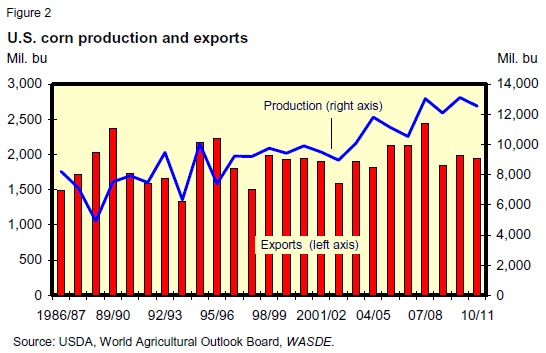
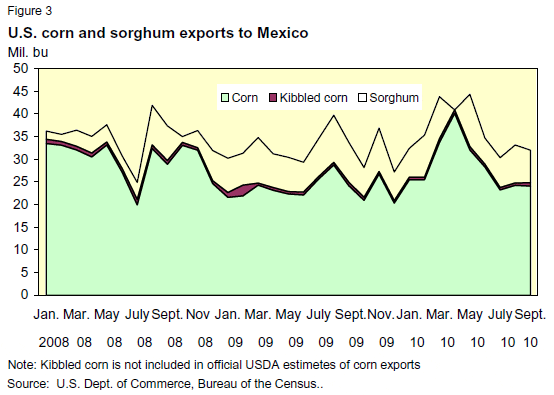
Sorghum
No changes were made to the U.S. sorghum supply and use numbers. Prices remain unchanged this month at $4.90-$5.70 per bushel, as compared to $3.22 per bushel in 2009/10.
Barley and Oats Prices Lowered This Month
Barley imports are lowered 5 million bushels to 10 million based on lower expected Canadian barley production. Total use is forecast at 220 million, down 5 million, reflecting lower food, seed, and industrial (FSI) use due to slow domestic beer consumption which is slowing demand for malting barley. As a result, ending stocks are forecast at 86 million unchanged from last month. The projected price range is lowered 5 cents on the low end of the range and 15 cents on the high end of the range, to $3.70-$4.10 per bushel for 2010/11, compared to $4.66 per bushel last year.
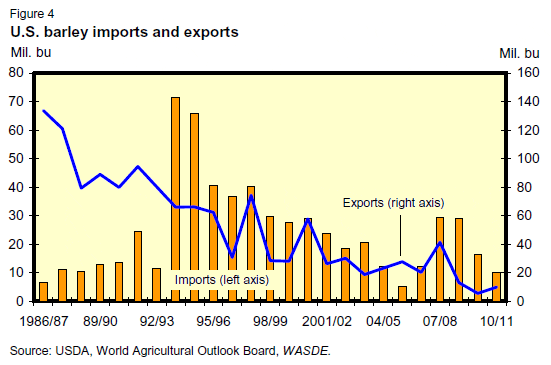
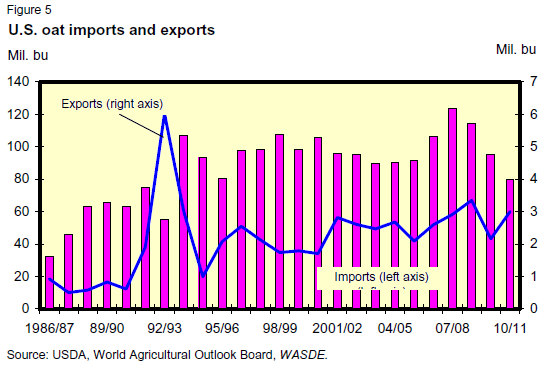
There are no changes this month to the U.S. oats supply and use numbers. Reflecting prices received to date by producers, the projected price range is lowered to $2.15-$2.35 per bushel, down 20 cents on the high end of the range. This compares with $2.02 per bushel in 2009.
International Outlook
World 2010/11 Coarse Grain Production Increased This Month
Global coarse grain production is projected to reach 1,088.6 million tons in 2010/11, up 3.4 million this month. World corn production is up 2.2 million tons to a record 820.7 million, global barley production is increased 0.6 million tons to 124.3 million, oats production is up 0.4 million tons to 20.5 million, millet production is increased 0.3 million tons to 32.1 million, and mixed grain is boosted slightly. However, world rye and sorghum production are reduced slightly this month.
Australia has the largest increase in coarse grain production this month, up 2.4 million tons to 13.9 million. Favorable rainfall during the growing season in the eastern part of the country more than offset drought in Western Australia. However, continued heavy rain during harvest has reduced the quality of small grains. Based on surveys by the Australian Bureau of Agricultural and Resource Economics and Sciences (ABARES), barley harvested area was reduced 100,000 hectares to 4.1 million, but record yields more than compensated, boosting production 1.9 million tons to 9.8 million. Oats area harvested was increased slightly and yield increased, but not to record levels. Oats production is up 0.49 million tons this month to 1.75 million.
India’s coarse grain production is increased 1.3 million tons this month to 41.6 million. Favorable rains extended beyond the normal monsoon period across most parts of India. Moreover, increased area is reported for corn and millet. Corn production is up 1.0 million tons this month to 21.0 million, and millet production is boosted 0.3 million tons to 11.8 million.
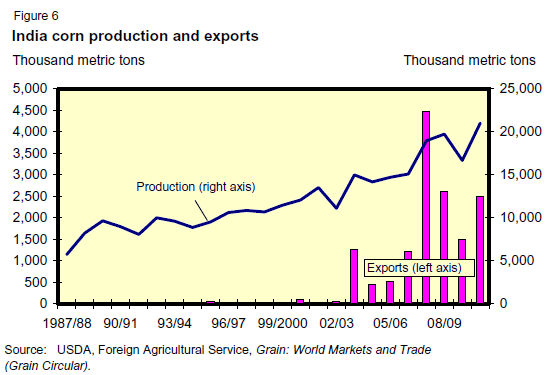
EU coarse grain production for 2010/11 is revised up 0.2 million tons to 139.0 million, with several small changes mostly offsetting. EU corn production is increased 0.4 million tons to 55.2 million, with increased production reported for Romania and Bulgaria. Rye was reported slightly higher in Poland, but there were small reductions in several countries for barley, oats, and sorghum.
Statistics Canada reported survey-based production data that made mostly offsetting changes in different coarse grains. Total coarse grain production is increased 0.1 million tons to 22.1 million. Record corn yield and production is reported, as the growing season in Eastern Canada was quite favorable, increasing corn production 0.7 million tons this month to 11.7 million. However, barley harvested area is reported lower, cutting production 0.6 million tons to 7.6 million. Increases in production for mixed grain and rye were small, and the reduction for oats was small also.
Coarse grain production changes for Ukraine were also mostly offsetting, with total production up 0.1 million tons to 21.8 million. Based on harvest reports, corn production is increased 0.5 million tons this month to 12.0 million, as good yields are reported despite searing temperatures during August. However, barley and oats yields were reported lower, trimming production 0.3 and 0.1 million tons, respectively.
Paraguay’s corn production prospects are reduced 0.35 million tons to 1.75 million, as early-season dryness has reduced area and yield prospects. Harvest reports trimmed yields in Russia for barley and rye, reducing production 0.2 and 0.1 million tons, respectively. Area for barley and corn in Kyrgyzstan was reported lower, trimming production slightly. There was also a slight reduction reported for barley yields in South Africa.
Global coarse grain beginning stocks for 2010/11 are reduced 0.8 million tons this month to 198.2 million, partly offsetting the boost in supplies caused by increased production. Based on a report from a USDA Foreign Agricultural Service post, Serbia’s corn feed and residual use estimated for 2008/09 and 2009/10 was increased, reducing beginning stocks 0.6 million tons to 1.0 million. The Australian Bureau of Statistics reported reduced barley production for 2009/10, and exports were estimated higher, combining to reduce 2010/11 beginning stocks 0.5 million tons to 1.9 million. For South Africa, reduced corn production for 2009/10 and increased feed use is only partly offset by lower exports, trimming corn beginning stocks for 2010/11 0.4 million tons to 5.2 million. For Mexico, reduced corn production for 2009/10 more than offset an increase for sorghum, trimming coarse grain beginning stocks for 2010/11 by 0.3 million tons to 1.9 million. There were smaller reductions in 2010//1 coarse grain beginning stocks for Argentina, Ukraine, India, Kyrgyzstan, and Japan. These reductions in beginning stocks for 2010/11 are partly offset by increased coarse grain beginning stocks in the EU, up 1.1 million tons to 25.2 million. Upwardly revised corn and barley production for 2009/10 and reduced 2009/10 corn feed use account for most of the increase. There are also small increases in 2010/11 beginning stocks of coarse grain this month for Venezuela, Egypt, Russia, and Algeria.
Global Coarse Grain Use Projected Higher
World coarse grain consumption for 2010/11 is forecast up 0.9 million tons this month to 1,124.9 million. The changes in projected use for individual countries are mostly offsetting, but the local marketing year trade changes, including a reduction in imports 0.8 million tons larger than the reduction in exports, boosts global disappearance by 0.8 million tons.
Australia’s coarse grain use in 2010/11 is up 1.0 million tons this month, with barley up 0.55 million ton, and oats increased 0.45 million. Rains during harvest have reduced crop quality, and much of the increased production is expected to move into feed channels or contribute to residual losses. India’s coarse grain use is projected up 0.9 million tons, with corn feed use boosted 0.5 million and food use of millet accounting for the rest of the increase. South Africa’s corn use is increased 0.3 million tons, with a small decline in food and industrial use partly offsetting the feed use increase. There are smaller increases this month for Algeria, Canada, Venezuela, and Israel.
Mexico’s corn use forecast for 2010/11 is reduced 1.0 million tons this month, in line with lower estimated use for the previous year. Most of the decline is in feed use. Serbia’s corn use is cut 0.4 million tons, with a small increase in food and industrial use partly offsetting the drop in corn feeding. Russia’s coarse grain use is trimmed 0.3 million tons, with reductions for barley and rye. There are smaller reductions this month in projected coarse grain use for Argentina, Paraguay, Ukraine, the United States, EU, and Kyrgyzstan.
World Coarse Grain Stocks Prospects Boosted 1 Percent This Month
Global coarse grain stocks are increased 1.7 million tons this month to 161.9 million tons. World corn stocks prospects are up 0.8 million tons to 130.0 million, while barley is increased 0.8 million tons to 22.0 million. Global oats stocks are up 0.2 million tons, but sorghum and rye are down slightly.
The largest increase in projected 2010/11 coarse grain ending stocks is for the EU, up 1.4 million tons to 12.2 million. EU corn stocks prospects are raised 1.0 million tons due to increased production estimated for 2009/10 and 2010/11 and reduced feed use estimated for 2009/10. Increased beginning stocks boost EU barley ending stocks 0.3 million tons despite a small reduction in 2010/11 production. Also, reduced oats feed use is projected, boosting ending stocks 0.1 million tons.
Australia’s coarse grain stocks prospects increased 0.6 million tons to 3.1 million due to increased barley and oats production. Serbia’s projected ending stocks are increased 0.6 million tons to 1.7 million as logistical problems limit corn export prospects and feed demand is sluggish. Ukraine’s ending stocks are boosted 0.2 million tons due to increased corn production. There are smaller increases in ending coarse grain stocks this month for the United States, Egypt, Argentina, and Russia.
South Africa’s coarse 2010/11 grain ending stocks are projected 0.7 million tons lower this month to 4.6 million. Reduced beginning stocks and increased corn feed use are driving the decline. Mexico’s coarse grain ending stocks are reduced 0.4 million tons to 3.3 million, with reductions for corn swamping a small increase for sorghum. There are smaller reductions in stocks prospects this month for Paraguay, India, Algeria, Canada, Kyrgyzstan, and Japan.
World Corn Trade Prospects Trimmed, U.S. Export Prospects Unchanged
Global corn trade is projected at 92.0 million tons in 2010/11 (October-September), down 1.2 million this month. The largest reduction in projected imports is for Mexico, down 1.0 million tons to 8.1 million. Sluggish feed demand is expected to limit imports as growth in meat production is not as robust as previously expected. Canada’s corn imports are trimmed 0.2 million tons to 1.6 million because of record production. These declines are partly offset by small increases for Algeria, where corn feed use is growing, and the United States, with a record-large Canadian corn crop next door.
Corn export prospects are revised for several countries. Brazil’s 2010/11 October- September trade year exports are reduced 1.0 million tons to 8.0 million, but the March-February local marketing year export prospects are left unchanged at 7.0 million. This means a larger portion of Brazil’s local marketing year exports are expected to be shipped between October 2011 and February 2012. Serbia’s corn exports are cut 0.8 million tons this month to 1.7 million as logistical constraints are expected to limit exports despite the large crop. Mexico’s export prospects are reduced slightly as well. Partly offsetting these reductions are increased corn export prospects for India, up 0.5 million tons to 2.5 million, and for Canada, up 0.2 million to 0.5 million. Both countries are harvesting record large corn crops.
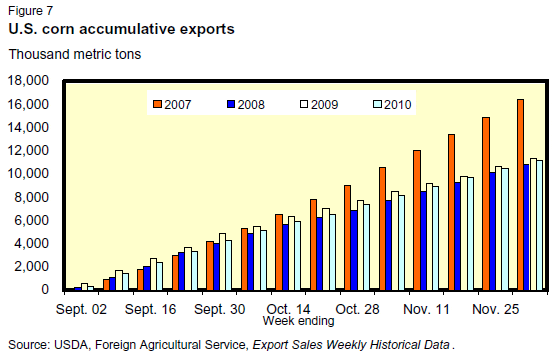
U.S. corn exports are forecast unchanged this month for 2010/11 at 50.0 million tons (1.95 billion bushels for the September-August local marketing year). Trade year 2010/11 corn exports are projected up less than 1 percent over those of the previous year. October 2010 corn exports were reported by Census at 3.4 million, slightly less than those of a year earlier, but November inspections were up 10 percent. Moreover, as of December 2, 2010, outstanding sales were 12.4 million tons, up from 10.1 million a year ago.
Global barley trade is reduced slightly this month as reduced production in Canada is expected to limit U.S. imports. Canada’s export prospects are trimmed 0.4 million tons to 1.0 million, but this is mostly offset by increased exports by Australia, with increased production prospects.
World sorghum trade for 2010/11 is forecast unchanged this month at 6.4 million tons. A small increase in EU imports is offset by a reduction in Mexico’s imports.
Further Reading
| - | You can view the full report by clicking here. |
December 2010


